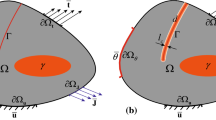Abstract
The paper presents the state-of-the-art algorithmic developments for simulating the fracture of disordered quasi-brittle materials using discrete lattice systems. Large scale simulations are often required to obtain accurate scaling laws; however, due to computational complexity, the simulations using the traditional algorithms were limited to small system sizes. In our earlier work, we have developed two algorithms: a multiple sparse Cholesky downdating scheme for simulating 2D random fuse model systems, and a block-circulant preconditioner for simulating 3D random fuse model systems. Using these algorithms, we were able to simulate fracture of largest ever lattice system sizes (L = 1024 in 2D, and L = 64 in 3D) with extensive statistical sampling. Our recent massively parallel simulations on 1024 processors of Cray-XT3 and IBM Blue-Gene/L have further enabled us to explore fracture of 3D lattice systems of size L = 128, which is a significant computational achievement. Based on these large-scale simulations, we analyze the scaling of crack surface roughness.
Similar content being viewed by others
References
Herrmann, H.J., Roux, S. (eds.): Statistical Models for the Fracture of Disordered Media. North-Holland, Amsterdam, (1990); Hansen, A., Roux, S.: Statistical toolbox for damage and fracture. In: Krajcinovic, D., van Mier, J.G.M. (eds.) Book Damage and Fracture of Disordered Materials, pp. 17–101. Springer Verlag, New York (2000); Alava, M.J., Nukala, P.K.V.V., Zapperi, S.: Statistical models of fracture. Adv. Phys. 55, 349–476 (2006)
Mandelbrot B.B., Passoja D.E. and Paullay A.J. (1984). Fractal character of fracture surfaces of metals. Nature (London) 308: 721–722
For a review see Bouchaud, E.: Scaling properties of cracks. J. Phys. Condens. Matter 9, 4319–4344 (1997); Bouchaud, E., The morphology of fracture surfaces, a tool to understand crack propagation in complex materials. Surf. Sci. Review & Lett. 10:794–814(2003)
Ponson, L., Bonamy, D., Bouchaud, E.: Two-dimensional scaling properties of experimental fracture surfaces Phys. Rev. Lett. 96, 035506(4pages) (2006)
Boffa J.M., Allain C. and Hulin J. (1998). Experimental analysis of fracture rugosity in granular and compact rocks. Eur. Phys. J. A 2: 281–289
Bonamy, D., Ponson, L., Prades, S., Bouchaud, E., Guillot, C.: Scaling exponents for fracture surfaces in homogeneous glass and glassy ceramics Phys. Rev. Lett. 97 135504 (4pages) (2006)
López J.M., Rodríguez M.A. and Cuerno R. (1997). Superroughening versus intrinsic anomalous scaling of surfaces. Phys. Rev. E 56: 3993–3998
de Arcangelis, L., Redner, S., Herrmann, H.J.: A random fuse model for breaking processes. J. Phys. (Paris) Lett. 46, 585–590 (1985); Sahimi, M., Goddard, J.D.: Elastic percolation models for cohesive mechanical failure in heterogeneous systems. Phys. Rev. B 33, 7848–7851 (1986)
Batrouni, G.G., Hansen, A.: Fracture in three-dimensional fuse networks. Phys. Rev. Lett. 80, 325–328 (1998); Hansen, A., Schmittbuhl, J.: Origin of the universal roughness exponent of brittle fracture surfaces: stress-weighted percolation in the damage zone. Phys. Rev. Lett. 90, 45504(4pages) (2003); Ramstad, T., Bakke, J.O.H., Bjelland, J., Stranden, T., Hansen A.: Correlation length exponent in the three-dimensional fuse network. Phys. Rev. E 70, 036123 (4pages) (2004)
Räisänen V.I., Alava M.J. and Nieminen R.M. (1998). Fracture of three-dimensional fuse networks with quenched disorder. Phys. Rev. B 58: 14288–14295
Räisänen V.I., Seppala E.T., Alava M.J. and Duxbury P.M. (1998). Quasistatic cracks and minimal energy surfaces. Phys. Rev. Lett. 80: 329–332
Parisi A., Caldarelli G. and Pietronero L. (2000). Roughness of fracture surfaces. Europhys. Lett. 52: 304–310
Barrett R. (1994). Templates for the Solution of Linear Systems: Building Blocks for Iterative Methods. 2nd edn. SIAM, Philadelphia
Briggs W.L., Van Emden H. and McCormick S.F. (2000). A Multigrid Tutorial, 2nd edn. SIAM, Philadelphia
Batrouni, G.G., Hansen, A., Nelkin, M.: Fourier acceleration of relaxation processes in disordered systems, Phys. Rev. Lett. 57, 1336–1339 (1986); Batrouni, G.G., Hansen, A.: Fourier acceleration of iterative processes in disordered systems, J. Stat. Phys. 52, 747–773 (1988)
O’Shaughnessy, B., Procaccia, I.: Analytical solution for diffusion on fractal objects. Phys. Rev. Lett. 54, 455–458 (1985); O’Shaughnessy, B., Procaccia, I.: Diffusion on fractals. Phys. Rev. A 32, 3073–3083 (1985)
Nukala, P.K.V.V., Simunovic, S.: An efficient algorithm for simulating fracture using large fuse networks. J. Phys. A: Math. Gen.36, 11403–11412 (2003); Nukala, P.K.V.V., Simunovic, S., Guddati, M.N.: An efficient algorithm for modelling progressive damage accumulation in disordered materials. Int. J. Numer. Meth. Eng. 62, 1982–2008 (2005)
Davis, T.A., Hager, W.W.: Modifying a sparse Cholesky factorization. SIAM J. Matrix Anal. Appl. 20(3), 606–627 (1999); Davis, T.A., Hager, W.W.: Multiple-rank modifications of a sparse Cholesky factorization. SIAM J. Matrix Anal. Appl. 22(4), 997–1013 (2001)
Nukala P.K.V.V. and Simunovic S. (2004). An efficient block-circulant preconditioner for simulating fracture using large fuse networks. J. Phys. A: Math. Gen. 37: 2093–2103
Balay, S., Buschelman, K., Gropp, W.D., Kaushik, D., Knepley, M.G., McInnes, L.C., Smith, B.F., Zhang, H.: PETSc Web page, http://www.mcs.anl.gov/petsc (2001); Balay, S., Buschelman, K., Eijkhout, V., Gropp, W.D., Kaushik, D., Knepley, M.G., McInnes, L.C., Smith, B.F., Zhang, H.: PETSc Users Manual, ANL- 95/11 - Revision 2.1.5. Argonne National Laboratory, Argonne, IL (2004); Balay, S., Gropp, W.D., McInnes, L.C., Smith, B.F.: Efficient Management of Parallelism in Object Oriented Numerical Software Libraries, In Arge, E., Bruaset, A.M., Langtangen, H.P. (eds.) Book: Modern Software Tools in Scientific Computing, pp. 163–202.
Parks, M.L., de Sturler, E., Mackey, G., Johnson, D.D., Maiti, S.: (2006) Recycling Krylov subspaces for sequence of linear systems. SIAM J. Sci. Comput. 28(5),1651–1674
Schmittbuhl J., Vilotte J.P. and Roux S. (1995). Reliability of self-affine measurements. Phys. Rev. E 51: 131–147
Zapperi, S., Nukala, P.K.V.V., Simunovic, S.: Crack roughness and avalanche precursors in the random fuse model Phys. Rev. E 71 026106 (10pages) (2005)
López J.M. and Schmittbuhl J. (1998). Anomalous scaling of fracture surfaces. Phys. Rev. E 57: 6405–6408
Morel S., Schmittbuhl J., López J.M. and Valentin G. (1998). Anomalous roughening of wood fractured surfaces. Phys. Rev. E 58: 6999–7005
Author information
Authors and Affiliations
Corresponding author
Rights and permissions
About this article
Cite this article
Nukala, P.K.V.V., Šimunović, S., Zapperi, S. et al. Fracture in three-dimensional random fuse model: recent advances through high-performance computing. J Computer-Aided Mater Des 14 (Suppl 1), 25–35 (2007). https://doi.org/10.1007/s10820-007-9080-y
Received:
Accepted:
Published:
Issue Date:
DOI: https://doi.org/10.1007/s10820-007-9080-y




